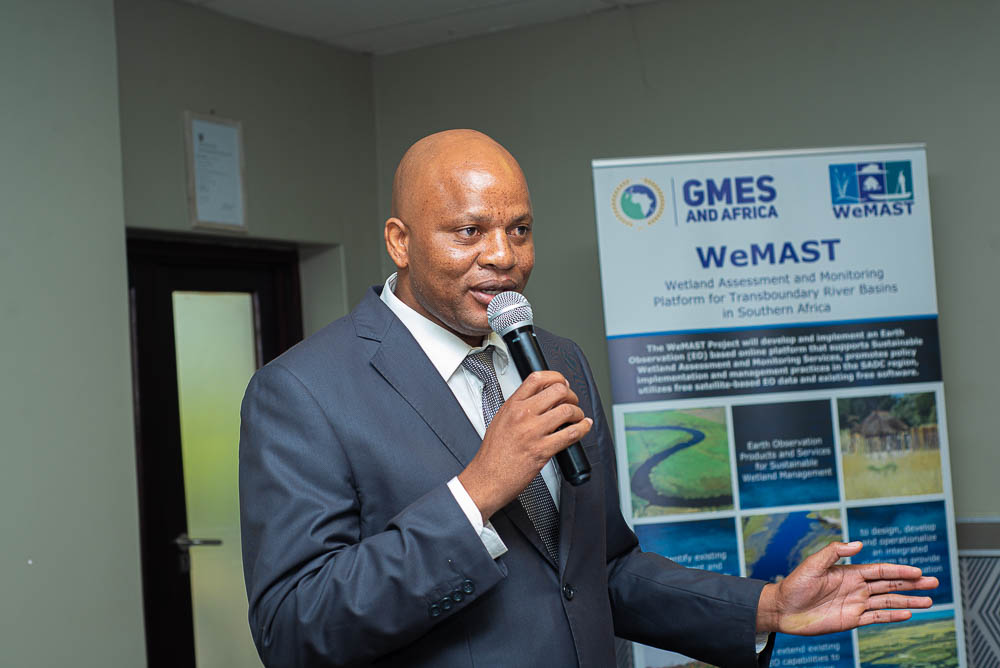By Joyce Mukucha and Anyway Yotamu
The Southern African Science Service Centre for Climate Change and Adaptive Land Management (SASSCAL) is spearheading the Wetland Assessment and Monitoring Platform for Transboundary River Basins in Southern Africa (WeMAST) project and has partnered various stakeholders in an effort to design, develop and operationalise an integrated Earth Observation(EO) based platform that provide wetland information services to target groups and end users to curb wetland degradation.
Wetlands are considered critical biological drivers of earth therefore the platform is set to support Sustainable Wetland Assessment and monitoring services, promote policy implementation and management practices in the Southern African Development Community (SADC) region. The target basins are; Cuvelai, Limpopo, Okavango and Zambezi covering Angola, Botswana, South Africa, Zambia and Zimbabwe.
In his presentation during a WeMAST Regional Stakeholder Engagement and User Needs Assessment Workshop held in Harare on the 4th of December 2019, Midlands State University Chairperson in the Department Of Geography and Environmental Studies who is also the WeMAST Principal Investigator, Dr Thomas Marambanyika said the wetlands were under threat due to limited information and data management to information planning and policy.
He added that wetlands were threatened by natural phenomena and anthropogenic activities that include land use and cover change, bush encroachment, climate change, agriculture, wildlife grazing, fires among other factors and urged stakeholders to embrace technologies to support wetland dialogue initiatives in the SADC region.
“This project is aimed at focusing on wetlands located in Southern African transboundary basins and it intends to be used in utilisation of free satellite based EO data and existing software. There are data gaps as well as insufficient information and coordination from different stakeholders in as much as the protection of wetlands is concerned. It is therefore imperative for the region to work tirelessly and embrace technologies to compliment wetland conversation initiatives around the region,” he said.
Concerning wetland assessment and monitoring frameworks in Zambia, the country is working on an Upper Zambezi Programme, a resilient Zambezi River Basin for the benefit of the people and nature which started in 2017 and will run up until 2027. The project is spearheading strategy development and implementation including programme design for partnerships, water stewardship, wetlands management, environmental flows and climate change adaptation among other priority areas. However, there is huge data primarily gaps particularly in the last three decades, Also, there is no systematic flow and data storage mechanisms.
Articulating on Cubane Okavango River Basin (CORB) the Water Resources Engineer in the Department of Water and Sanitation in Botswana Mr Pako Modiakgotla said Botswana is a land locked country which depend on its transboundary water resources for access and the nation is in fear that if the catchments are cut, Botswana might run dry following that from 2014 the water is depleting.
“We are having challenges concerning monitoring and assessment which include poverty levels in the basin that are actually high following that people there depends on natural resources. Also there is pressure on natural resources, invasive alien species and water distraction from perennial rivers, aquifers and ephemeral wetlands among other challenges. In line with this, and in an effort to promote sustainable wetland utilisation, monitoring and assessment, it is important to have indigenous knowledge systems and this EO will be of great use in the region,” he said.
Pako stressed that it was imperative to have a complete wetland monitoring framework that provide adequate information on the protection of wetlands. Holistic data collection, he said, and improved instrumentation, coordination and integration between poor organisations was significant.
Speaking from a traditional point of view concerning Driefontein wetland, the Headman of Chirumhanzi, Peter Dzingai said his community was prepared to join hands and protect the wetland in the area if researchers work closely with traditional leaders in the implementation of the EO.
“Meanwhile, the community is fully aware about the importance of wetlands preservation but the worry is if they adhere to protect those wetlands how are they going to survive because it where their agricultural projects depend on. So I urge the Government and stakeholders such as Environmental Management Agency to continue visit the area and impart as much knowledge as they can to the people as well as giving them new alternatives for survival,” said Dzingai.
Other participants at the workshop suggested that the platform should consider starting to extend the idea to the grassroots levels so that it accommodates everyone as well consider the existing EO capabilities to SADC decision makers for wetland assessment and monitoring for the implementation to become effective. Research institutions have been indicated as important key players in establishing the EO.
The WeMAST project is funded by the GMES and Africa Support Programme and is implemented by a consortium led by (SASSCAL) , a leading regional centre in integrated climate change and adaptive land management science services for improved quality of life in Southern Africa. The organisation works with partners that include South African National Space Agency (SANSA), University of Western Cape, South Africa (UWC), Midland State University9MSU), Zambia National Remote Sensing Centre (NRSC), University of Zambia (UNZA) and University of Botswana (UB).
